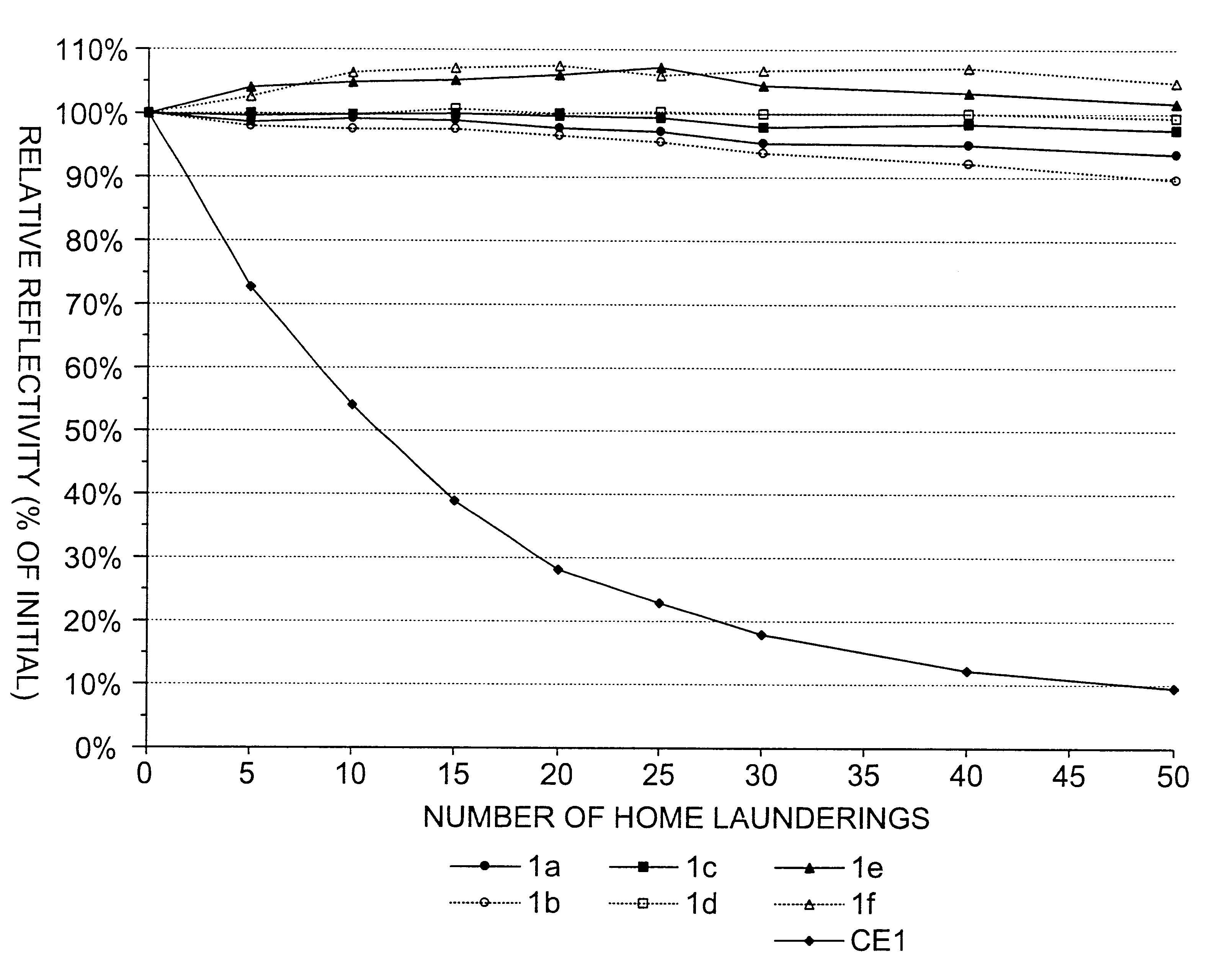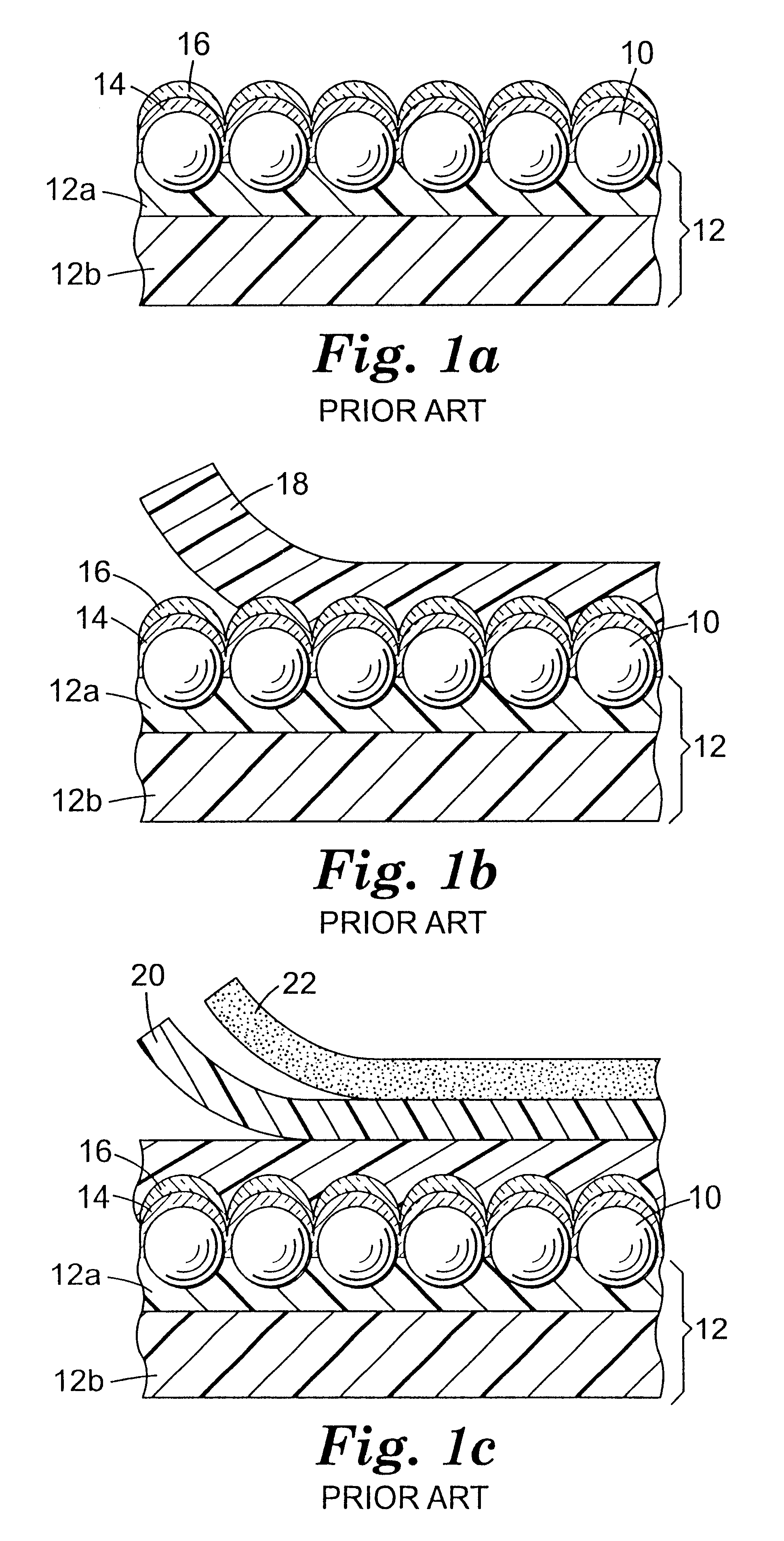Dielectric mirror retroreflective appliques having excellent repetitive laundering performance
a technology of retroreflective appliques and mirrors, applied in the direction of reflex reflectors, thin material handling, instruments, etc., can solve the problems of repetitive home laundering performance that varies considerably, appliques with long beeps that exhibit a reflectivity that degrades from an initial value much faster, and fireman's jackets that tend to get badly soiled
- Summary
- Abstract
- Description
- Claims
- Application Information
AI Technical Summary
Benefits of technology
Problems solved by technology
Method used
Image
Examples
example 1
Some transfer graphic appliques were made as set forth above. Six samples (designated 1a, 1b, 1c, 1d, 1e, and 1f) within this Example 1 were made having slightly different thicknesses of calcium fluoride (CaF.sub.2) as the low index material. Samples 1a and 1b had the smallest thickness, samples 1c and 1d had an intermediate thickness, and samples 1e and 1f had the largest thickness. Spectral measurements that were evaluated with a best fit technique yielded estimated thicknesses for sample 1a of about 101 and 68 nm for the CaF.sub.2 and ZnS layers respectively, about 137 and 64 nm for the corresponding layers of sample 1c, and about 159 and 75 nm for the corresponding layers of sample 1e. Except for the differences in fabrication noted above, the samples of this Example 1 were all processed and tested together with comparison example CE1: the application of bead bond material 18 was done in the same manner and with the same batch of material; the substrate fabric was the same and w...
example 2
Some more transfer graphic appliques were made as set forth above. Like inventive Example 1, different samples (designated 2a, 2b, and 2c) were made having slightly different thicknesses of the low index material CaF.sub.2. Except for the differences in fabrication noted above, the samples of this Example 2 were processed and tested together with comparison example CE2: the application of bead bond material 18 was done in the same manner and with the same batch of material; the substrate fabric was the same and was laminated to each applique in the same manner; the samples were all washed simultaneously in the same washing machine and dried simultaneously in the same dryer; and the brightness (reflectivity) measurements were taken at about the same time using the same equipment. The average initial reflectivity of samples 2a, 2b, and 2c was about 55, 80, and 70 cd / (lux.multidot.m.sup.2) respectively. Despite these differences, all of the samples showed excellent stability under repe...
examples 3 , 4
Examples 3, 4
Still more transfer graphic appliques were made as set forth above. Four samples, designated 3a, 3b, 3c, and 3d, were all processed in the same fashion, except that the geometry of the inductively heated holder for the calcium fluoride source material was slightly different for sample 3d. Five more samples, designated 4a through 4e, were made as described in Table 3 by e-beam evaporation of both the high and low index dielectric mirror layers. Except for those differences in dielectric mirror construction, the samples of these Examples 3 and 4 were all processed and tested together with comparison example CE3: the application of bead bond material 18 was done in the same manner and with the same batch of material; the substrate fabric was the same and was laminated to each applique in the same manner; the samples were all washed simultaneously in the same washing machine and dried simultaneously in the same dryer; and the brightness (reflectivity) measurements were take...
PUM
 Login to View More
Login to View More Abstract
Description
Claims
Application Information
 Login to View More
Login to View More - R&D
- Intellectual Property
- Life Sciences
- Materials
- Tech Scout
- Unparalleled Data Quality
- Higher Quality Content
- 60% Fewer Hallucinations
Browse by: Latest US Patents, China's latest patents, Technical Efficacy Thesaurus, Application Domain, Technology Topic, Popular Technical Reports.
© 2025 PatSnap. All rights reserved.Legal|Privacy policy|Modern Slavery Act Transparency Statement|Sitemap|About US| Contact US: help@patsnap.com



